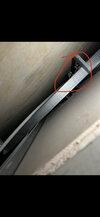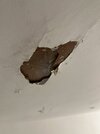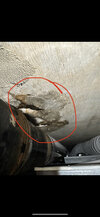- Joined
- 2 Jan 2023
- Messages
- 5
- Reaction score
- 0
- Country

Hi there,
Since we moved in to a newly built house we noticed annoying damp stains, patches and the paint crumbling in a living room floor are - you can see it from the staircase. We've been trying to establish the potential cause of the issue and we failed. Had a plumber testing our boiler and underfloor heating - nothing was found. Leakage detection company could not find anything odd. A couple of days ago, we noticed an actual leakage with the water dripping down the ceiling in our basement level. It also started leaking from the floor connected with the staircase. We're starting an insurance claim. An emergency plumber cut holes in the ceiling to access and be able to view the issue. He could not locate the exact location of the leakage and advised to turn off the water supply in order to dry the area and to be able to return and investigate further.
We turned off the water supply just before the new year (31.12.2022) - we were hoping that the leakage would stop completely after no water is circling around the house. The leakage calmed down. On 01/01/2022 we came back home at 9pm and we have noticed a much worse water leakage from the same spots. To add, on both occasions there was a rainfall present. Right now, we woke up to a good weather with no rain and the leakage is much slower than it was yesterday. We have an internal drainage system and the roof is a hipped sedum roof with a small skylight at the top. I'm inserting some images of the ceiling in the basement level. I'm a bit
baffled as to why there seem to be two holes up the concrete - the insert seems to be white PVC pipe of some sort. We're desperately trying to find the answer - is it the plumbing issue or the roof is letting water in. The fourth image shows the small study room, above our bathroom. The last image shows the initial area of our concern when we moved in. There are some white sticky sheets covering the floor, suggesting the builder tried to cover it up.
I would really appreciate any form of input.


Since we moved in to a newly built house we noticed annoying damp stains, patches and the paint crumbling in a living room floor are - you can see it from the staircase. We've been trying to establish the potential cause of the issue and we failed. Had a plumber testing our boiler and underfloor heating - nothing was found. Leakage detection company could not find anything odd. A couple of days ago, we noticed an actual leakage with the water dripping down the ceiling in our basement level. It also started leaking from the floor connected with the staircase. We're starting an insurance claim. An emergency plumber cut holes in the ceiling to access and be able to view the issue. He could not locate the exact location of the leakage and advised to turn off the water supply in order to dry the area and to be able to return and investigate further.
We turned off the water supply just before the new year (31.12.2022) - we were hoping that the leakage would stop completely after no water is circling around the house. The leakage calmed down. On 01/01/2022 we came back home at 9pm and we have noticed a much worse water leakage from the same spots. To add, on both occasions there was a rainfall present. Right now, we woke up to a good weather with no rain and the leakage is much slower than it was yesterday. We have an internal drainage system and the roof is a hipped sedum roof with a small skylight at the top. I'm inserting some images of the ceiling in the basement level. I'm a bit
baffled as to why there seem to be two holes up the concrete - the insert seems to be white PVC pipe of some sort. We're desperately trying to find the answer - is it the plumbing issue or the roof is letting water in. The fourth image shows the small study room, above our bathroom. The last image shows the initial area of our concern when we moved in. There are some white sticky sheets covering the floor, suggesting the builder tried to cover it up.
I would really appreciate any form of input.






